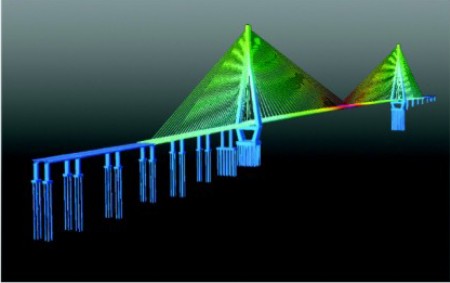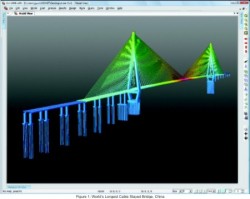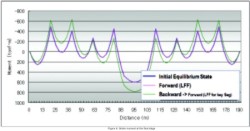Forward Analysis for a Cable Stayed Bridge

Vinayagamoorthy Marriap Sr. Technical Support Engineer, MIDAS R&D Centre, Mumbai
Overview
In general, to design a cable-stayed bridge, a final system (completed system) analysis and a construction stage analysis are required. From the final system (completed system) analysis, dimensions of a structure, cross section of cables and cable forces are determined.Depending on the erection method, the structural system of a cable-stayed bridge can be changed greatly. And the change of structural system can cause an unstable state during construction. In this regard, construction stages should be composed in a way that the construction stages, which affect the structural system, are included and should be used to check the structural safety. When the analysis is performed following the erection sequence to fulfil this purpose, it is called Forward Analysis. Through the forward analysis, stresses in construction stages, construction sequence and possibility of construction can be checked and an optimal construction method can be selected.
The reason for being difficult to apply forward analysis to a cable-stayed bridge is that the cable forces to be introduced at each construction stage are hard to know. In Korea, most of cable-stayed bridges have been designed by using backward analysis followed by forward analysis. From the backward analysis cable forces were determined, and afterwards using these cable forces the forward analysis was carried out.

This problem is caused by not understanding the cable theory or by no existence of software taking care of this problem except for the software dealing with large displacement.
But the above mentioned is unreasonable according to the following reasons:
- Within elastic range, forward analysis result is the same as the backward analysis result. (e.g., not considering time-dependent effects).
- If the key segment closure force is calculated, both forward and backward analyses will have the same result as that from initial equilibrium state analysis.
'Lack-of-Fit Force'(LFF) signifies 'Additional Pretension', which is introduced during the cable installation where the change of structural behavior and structural system are considered, or 'Pre-applied Force', which is pre-applied to the key segment so that the key segment can be located at the same position as the completed system when the key segment is to be closed. During the forward analysis, if the program calculates the 'Lack-of-Fit Forces' for the cable and key segment elements and these 'Lack-of-Fit Forces' are reflected in the installation of cable and key segment, the final stage result from the forward analysis will coincide with the result from the initial equilibrium state analysis.
Test Model (3 span cable stayed bridge)

Test Model is a 2D 3-span continuous symmetrical cable stayed bridge. The total bridge length is 170m (40+90+40). The 8 cables are supporting the bridge.

As seen in the results, when the forward analysis without considering LFF is used (and the cable force for each stage is calculated by backward analysis), less cable pretension than it should be introduced, so the displacement at the final stage is greater than the displacement from the initial equilibrium state analysis and the cable force is smaller as a whole. Likewise, girder has the greater positive and negative moments than those from the initial equilibrium state analysis. On the other hand, when the forward analysis using LFF is used (and the cable force is calculated from the initial equilibrium state analysis), the displacements at tower and girder, the girder moment and the cable force are the same as those from the initial equilibrium state analysis.

Conclusion
Forward analysis is carried out following the construction sequence and backward analysis is performed by removing structural members step by step from the completed system. Up to now, after initial equilibrium state analysis (at completed system) has been performed, backward analysis has been performed to find the cable forces for each stage and then based on these cable forces forward analysis has been performed. However, backward analysis is inconvenient compared to forward analysis and time dependent effects cannot be reflected in the backward analysis. According to the cable theory, forward analysis and backward analysis give the same result within elastic range as long as the unstressed cable length are obtained from the initial equilibrium state analysis (at completed system). In this test model case, we have seen that it is possible to analyze a cable stayed bridge, using Lack of Fit Force function, by forward analysis alone without backward analysis.
NBM&CW November 2008


















